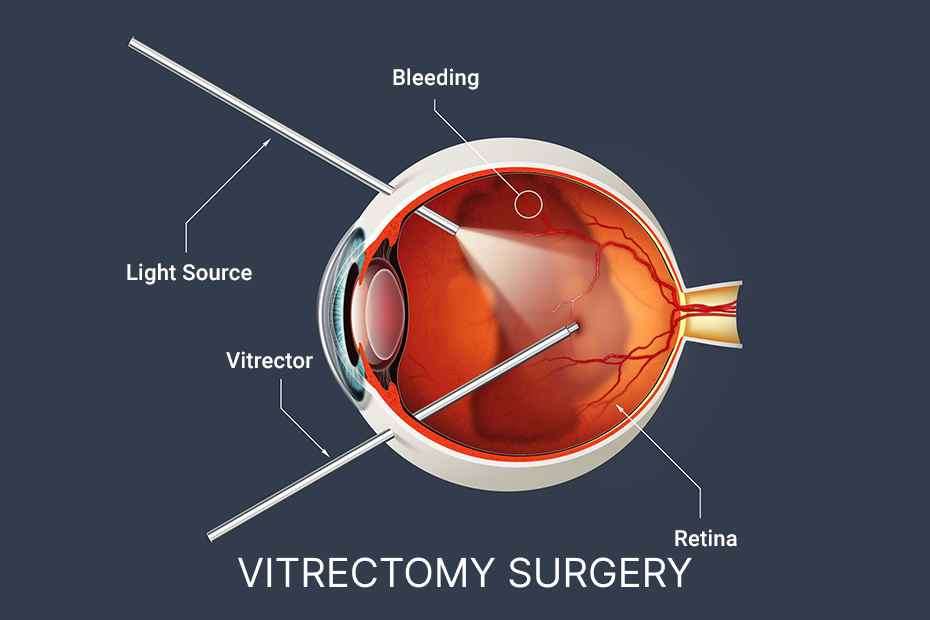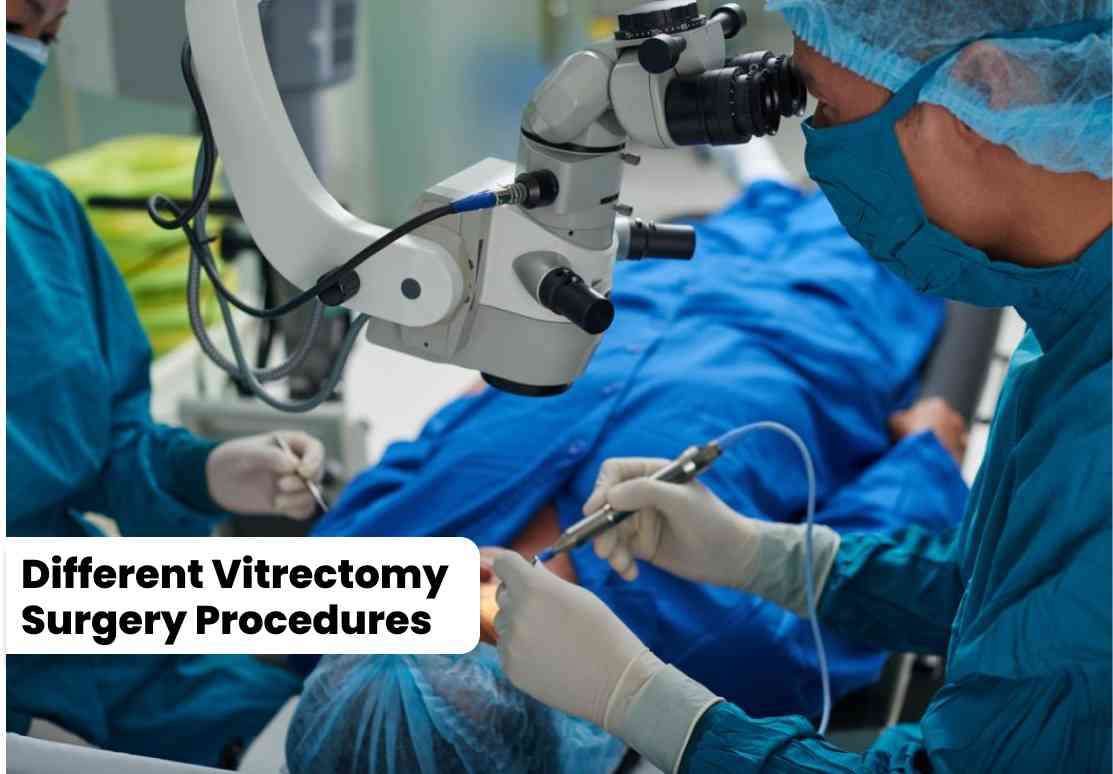Vitrectomy surgery is a surgical procedure performed to treat various conditions affecting the vitreous gel inside the eye. Call us to book a appointment with the best eye specialist near you.
Vitrectomy surgery is a surgical procedure performed on the eye to treat various conditions affecting the vitreous humor, a gel-like substance that fills the center of the eye. The vitreous humor helps maintain the shape of the eye and allows light to pass through to the retina at the back of the eye.

Vitrectomy surgery is a surgical procedure performed on the eye to treat various conditions affecting the vitreous humor, a gel-like substance that fills the center of the eye. The vitreous humor helps maintain the shape of the eye and allows light to pass through to the retina at the back of the eye.
1. Pars Plana Vitrectomy (PPV): This is the most widely used and standard vitrectomy technique. It involves creating three small incisions in the sclera (white part of the eye) near the pars plana, which is the area between the colored iris and the retina. Tiny instruments are then inserted through these incisions to remove the vitreous gel. 2. 25-Gauge, 23-Gauge, or 27-Gauge Vitrectomy: These procedures refer to the size of the instruments used in vitrectomy surgery. Smaller gauge instruments result in smaller incisions and potentially faster recovery times. 3. Combined Vitrectomy with Cataract Surgery: In some cases, when a patient has both a cataract and a vitreous-related condition, the surgeon may choose to perform a combined procedure. This involves removing the vitreous and replacing it with a clear fluid while also removing the clouded natural lens and replacing it with an intraocular lens implant to improve vision. 4. Vitrectomy with Endolaser: Endolaser photocoagulation is often performed during vitrectomy surgery for conditions like diabetic retinopathy or retinal tears. Laser energy is applied to create small burns or scars on the retina to seal leaking blood vessels or fix retinal tears. 5. Vitrectomy with Gas or Silicone Oil Injection: After vitrectomy, the surgeon may inject a gas bubble or silicone oil into the eye to help maintain the shape and position of the retina during healing. These substances provide internal support and can aid in the reattachment of the retina in cases of retinal detachment.

1. Pars Plana Vitrectomy (PPV): This is the most widely used and standard vitrectomy technique. It involves creating three small incisions in the sclera (white part of the eye) near the pars plana, which is the area between the colored iris and the retina. Tiny instruments are then inserted through these incisions to remove the vitreous gel.
2. 25-Gauge, 23-Gauge, or 27-Gauge Vitrectomy: These procedures refer to the size of the instruments used in vitrectomy surgery. Smaller gauge instruments result in smaller incisions and potentially faster recovery times.
3. Combined Vitrectomy with Cataract Surgery: In some cases, when a patient has both a cataract and a vitreous-related condition, the surgeon may choose to perform a combined procedure. This involves removing the vitreous and replacing it with a clear fluid while also removing the clouded natural lens and replacing it with an intraocular lens implant to improve vision.
4. Vitrectomy with Endolaser: Endolaser photocoagulation is often performed during vitrectomy surgery for conditions like diabetic retinopathy or retinal tears. Laser energy is applied to create small burns or scars on the retina to seal leaking blood vessels or fix retinal tears.
5. Vitrectomy with Gas or Silicone Oil Injection: After vitrectomy, the surgeon may inject a gas bubble or silicone oil into the eye to help maintain the shape and position of the retina during healing. These substances provide internal support and can aid in the reattachment of the retina in cases of retinal detachment.
Vitrectomy surgery is generally considered safe and effective, but like any surgical procedure, it carries some risks and potential complications. 1. Infection: There is a risk of developing an infection in the eye after surgery, although this is rare. Symptoms may include pain, redness, swelling, or discharge from the eye. Prompt medical attention is required if an infection is suspected. 2. Bleeding: During vitrectomy, there is a small risk of bleeding in the eye. This can occur during the surgery or in the postoperative period. If bleeding is significant, it may require additional treatment or intervention. 3. Retinal Detachment: While vitrectomy is often performed to treat retinal detachment, there is a small risk of the retina detaching or becoming displaced during or after the procedure. Additional surgeries or treatments may be necessary to address this complication. 4. Cataract Formation: Vitrectomy surgery can accelerate the development or progression of cataracts in the eye. This occurs due to the removal of the natural lens during the procedure or the effects of the surgery on the lens. If a cataract forms or worsens, it may require additional surgery to remove and replace the cloudy lens. 5. Increased Eye Pressure: Some individuals may experience an increase in intraocular pressure (IOP) after vitrectomy surgery. This can be temporary and managed with medications, but in some cases, it may require further treatment or monitoring. 6. Macular Edema: Macular edema refers to swelling of the central part of the retina called the macula. It can occur as a result of the surgery or as a preexisting condition. Macular edema may cause blurry or distorted vision and may require additional treatment. 7. Visual Disturbances: It's possible to experience temporary or permanent changes in vision following vitrectomy surgery. These may include blurry vision, double vision, or decreased visual acuity. In most cases, vision improves over time, but it's important to have realistic expectations and follow up with your ophthalmologist for proper evaluation and management.

Vitrectomy surgery is generally considered safe and effective, but like any surgical procedure, it carries some risks and potential complications.
1. Infection: There is a risk of developing an infection in the eye after surgery, although this is rare. Symptoms may include pain, redness, swelling, or discharge from the eye. Prompt medical attention is required if an infection is suspected.
2. Bleeding: During vitrectomy, there is a small risk of bleeding in the eye. This can occur during the surgery or in the postoperative period. If bleeding is significant, it may require additional treatment or intervention.
3. Retinal Detachment: While vitrectomy is often performed to treat retinal detachment, there is a small risk of the retina detaching or becoming displaced during or after the procedure. Additional surgeries or treatments may be necessary to address this complication.
4. Cataract Formation: Vitrectomy surgery can accelerate the development or progression of cataracts in the eye. This occurs due to the removal of the natural lens during the procedure or the effects of the surgery on the lens. If a cataract forms or worsens, it may require additional surgery to remove and replace the cloudy lens.
5. Increased Eye Pressure: Some individuals may experience an increase in intraocular pressure (IOP) after vitrectomy surgery. This can be temporary and managed with medications, but in some cases, it may require further treatment or monitoring.
6. Macular Edema: Macular edema refers to swelling of the central part of the retina called the macula. It can occur as a result of the surgery or as a preexisting condition. Macular edema may cause blurry or distorted vision and may require additional treatment.
7. Visual Disturbances: It's possible to experience temporary or permanent changes in vision following vitrectomy surgery. These may include blurry vision, double vision, or decreased visual acuity. In most cases, vision improves over time, but it's important to have realistic expectations and follow up with your ophthalmologist for proper evaluation and management.
Vitrectomy surgery is a specialized procedure that offers several potential benefits for individuals with certain eye conditions. Here are some general advantages of vitrectomy surgery: 1. Treatment of Retinal Disorders: Vitrectomy is commonly performed to treat various retinal disorders, such as retinal detachment, macular hole, diabetic retinopathy, vitreous haemorrhage, and epiretinal membrane. By removing the vitreous gel and addressing the underlying issue, vitrectomy can help restore or improve vision and prevent further progression of the condition. 2. Retinal Detachment Repair: Vitrectomy is a crucial component of retinal detachment repair. It allows the surgeon to access and address the detached retina by removing any traction or scar tissue, repairing tears, and reattaching the retina to its proper position. This helps restore vision and prevent permanent vision loss. 3. Macular Hole Closure: For individuals with a macular hole, vitrectomy surgery can be performed to remove the vitreous gel and close the hole. By closing the hole, it helps restore central vision and improve visual acuity. 4. Removal of Vitreous Opacities: Vitrectomy surgery is often performed to remove vitreous opacities, such as floaters or blood in the vitreous humor. These opacities can significantly impair vision and cause visual disturbances. By removing them, vitrectomy can enhance visual clarity and quality of life. 5. Access for Treatment: Vitrectomy provides the surgeon with direct access to the retina and other structures within the eye. This enables the performance of additional treatments during the procedure, such as endolaser photocoagulation for diabetic retinopathy or retinal tears, or the injection of a gas or silicone oil to support retinal reattachment. 6. Combined Procedures: Vitrectomy surgery can be combined with other ocular procedures, such as cataract surgery or lens implantation. This allows for the simultaneous treatment of multiple eye conditions and potentially reduces the need for separate surgeries and recovery periods. 7. Improved Vision and Visual Function: Overall, vitrectomy surgery aims to improve or restore vision, reduce visual disturbances, and enhance visual function. By addressing the underlying conditions or complications affecting the retina and vitreous, vitrectomy can significantly improve an individual's ability to see and function visually.

Vitrectomy surgery is a specialized procedure that offers several potential benefits for individuals with certain eye conditions. Here are some general advantages of vitrectomy surgery:
1. Treatment of Retinal Disorders: Vitrectomy is commonly performed to treat various retinal disorders, such as retinal detachment, macular hole, diabetic retinopathy, vitreous haemorrhage, and epiretinal membrane. By removing the vitreous gel and addressing the underlying issue, vitrectomy can help restore or improve vision and prevent further progression of the condition.
2. Retinal Detachment Repair: Vitrectomy is a crucial component of retinal detachment repair. It allows the surgeon to access and address the detached retina by removing any traction or scar tissue, repairing tears, and reattaching the retina to its proper position. This helps restore vision and prevent permanent vision loss.
3. Macular Hole Closure: For individuals with a macular hole, vitrectomy surgery can be performed to remove the vitreous gel and close the hole. By closing the hole, it helps restore central vision and improve visual acuity.
4. Removal of Vitreous Opacities: Vitrectomy surgery is often performed to remove vitreous opacities, such as floaters or blood in the vitreous humor. These opacities can significantly impair vision and cause visual disturbances. By removing them, vitrectomy can enhance visual clarity and quality of life.
5. Access for Treatment: Vitrectomy provides the surgeon with direct access to the retina and other structures within the eye. This enables the performance of additional treatments during the procedure, such as endolaser photocoagulation for diabetic retinopathy or retinal tears, or the injection of a gas or silicone oil to support retinal reattachment.
6. Combined Procedures: Vitrectomy surgery can be combined with other ocular procedures, such as cataract surgery or lens implantation. This allows for the simultaneous treatment of multiple eye conditions and potentially reduces the need for separate surgeries and recovery periods.
7. Improved Vision and Visual Function: Overall, vitrectomy surgery aims to improve or restore vision, reduce visual disturbances, and enhance visual function. By addressing the underlying conditions or complications affecting the retina and vitreous, vitrectomy can significantly improve an individual's ability to see and function visually.
|
Serial No |
CITY |
MINIMUM COST (INR) |
AVERAGE COST(INR) |
|
1 |
Mumbai |
50,000 |
2, 00,000 |
|
2 |
Delhi |
50,000 |
2, 00,000 |
|
3 |
Bangalore |
50,000 |
2, 00,000 |
|
4 |
Chennai |
50,000 |
2, 00,000 |
|
5 |
Kolkata |
50,000 |
2, 00,000 |
|
Serial No |
Hospital Name |
Address |
Phone number |
|
1 |
Sanakara Nethralaya, Chennai |
No 41, College Road, Nungambakkam, Chennai - 600034 (Opposite Womens Christian College) |
+917947128038 |
|
2 |
Aravind Eye Hospital, Madurai |
No 1, Anna Nagar Main Road, Anna Nagar Madurai, Madurai - 625020 (Near Star Residency Hotel, Near Anna Bus Stand) |
+917947130629 |
|
3 |
L V Prasad Eye Institute, Hyderabad |
Kallam Anji Reddy Campus, Road No 2, Banjara Hills, Hyderabad - 500034 (Opposite Pvr Cinemas, Beside Telugu Desham Party Office) |
+917947135051 |
|
4 |
Dr. Aggarwal's Eye Hospital, Chennai |
No 222, TTK Road, Alwarpet, Chennai - 600018 (Near Raj Park Hotel) |
+918197047297 |
|
5 |
Maxivisions Eye Hospital, Hyderabad |
Door No 6-3-903/A/1/1, Somajiguda, Hyderabad - 500082 (Beside Yashoda Hospital) |
+917942677684 |
|
6 |
All India Institute of Medical Sciences, Delhi |
Ansari Nagar East-aiims, Delhi - 110029 |
011 20588500 |
Please Wait..